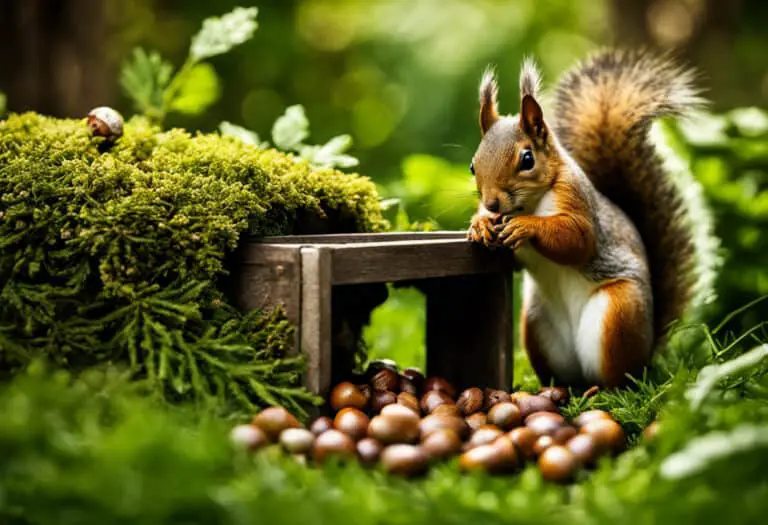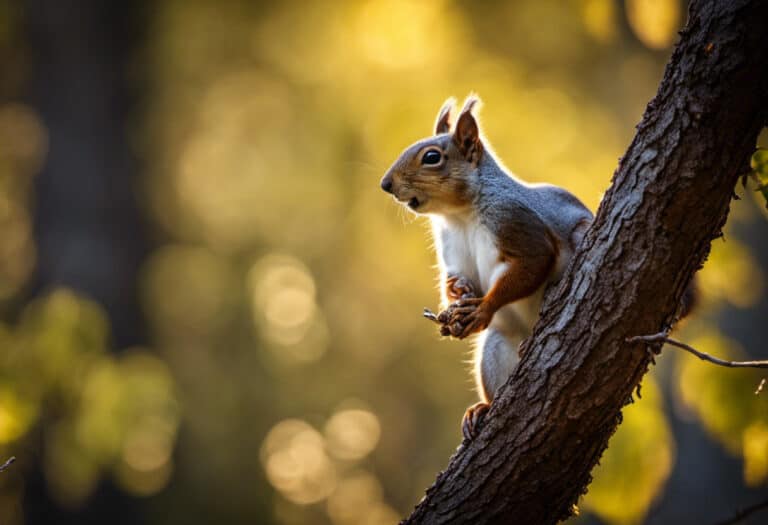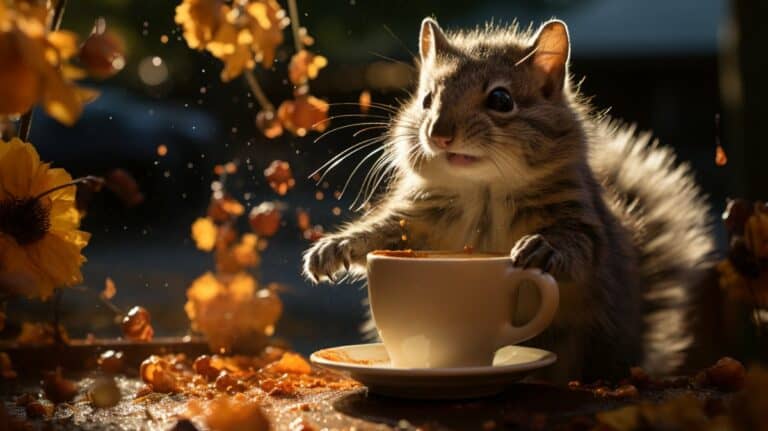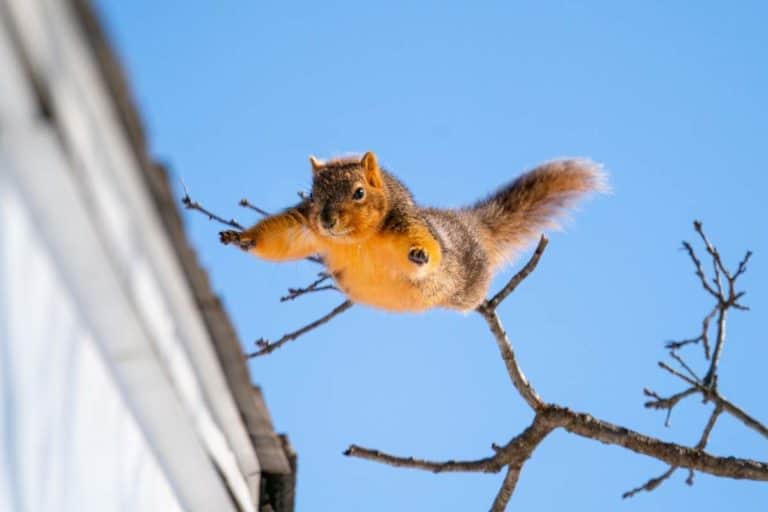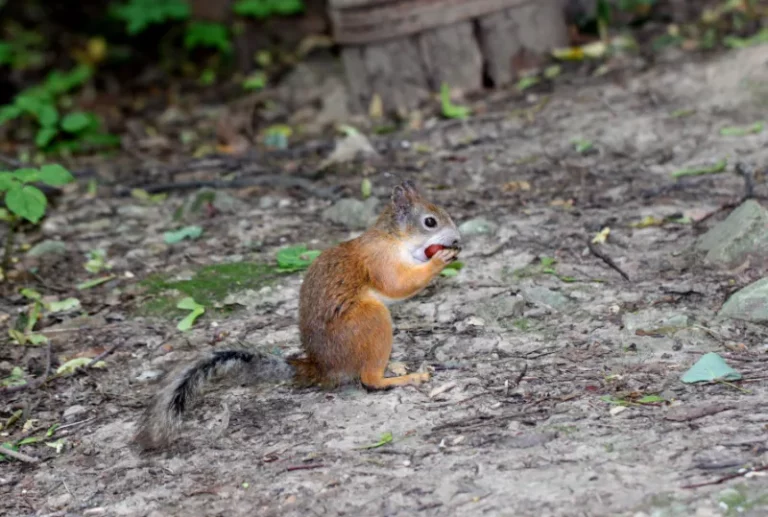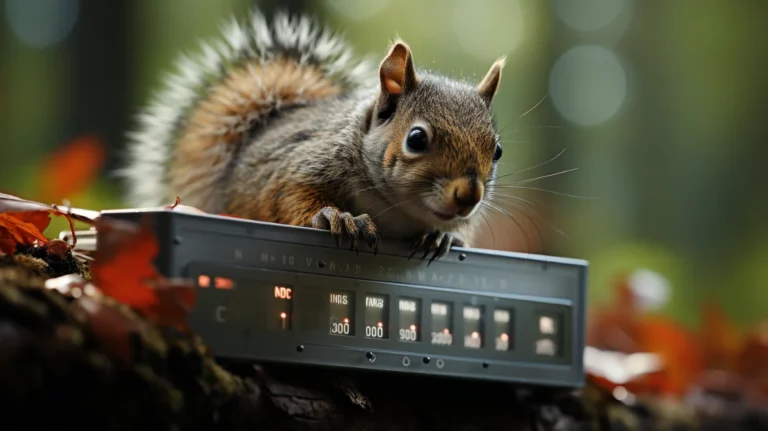How to Trap a Red Squirrel
Are you tired of those pesky red squirrels wreaking havoc in your yard? Well, trapping them might just be the answer you’ve been looking for.
In this article, we’ll guide you through the process of trapping a red squirrel, step by step.
From understanding their behavior to choosing the perfect trap and baiting techniques, we’ve got you covered.
So, grab your gear and get ready to outsmart those furry troublemakers once and for all.
Key Takeaways
- Look for areas with abundant food sources like nut-bearing trees or bird feeders.
- Set traps along established trails and pathways.
- Identify squirrel nests in trees as prime trapping locations.
- Set traps near water sources like creeks or ponds.
Understanding Red Squirrels
To understand red squirrels, you’ll need to learn about their habitats, behaviors, and preferred food sources.
Red squirrels (Sciurus vulgaris) are small, arboreal rodents commonly found in forests across North America and Europe. These agile creatures have adapted to a variety of habitats, including coniferous and deciduous forests, as well as urban parks and gardens.
Their behavior is characterized by their energetic and acrobatic movements, as they leap from tree to tree, searching for food and navigating their surroundings. Red squirrels are known for their territorial nature, often fiercely defending their territories against other squirrels.
Their preferred food sources include a variety of nuts, seeds, and berries, which they can store in caches for future consumption. Understanding red squirrel behavior and habitat preferences is crucial when attempting to trap or observe these fascinating creatures.
Identifying the Best Trapping Locations
Finding the best spots for trapping can be challenging, but it’s crucial for a successful squirrel trapping strategy. To help you in your quest, here are some key tips for identifying the most effective trapping locations:
-
Food Sources: Look for areas with abundant food sources, such as nut-bearing trees or bird feeders. Squirrels are likely to frequent these spots.
-
Trails and Pathways: Squirrels follow established trails and pathways, so setting traps along these routes increases your chances of success.
-
Nesting Areas: Identify squirrel nests, or dreys, in trees. These are prime locations for trapping, as squirrels often return to their nests.
-
Water Sources: Squirrels need water to survive, so setting traps near water sources, such as creeks or ponds, can attract them.
-
Camouflage: Use natural materials to camouflage your traps. Squirrels are wary creatures, so blending them into their surroundings increases the chances of trapping success.
By employing these trapping techniques and utilizing camouflage strategies, you can increase your chances of successfully trapping red squirrels.
Remember to check your local regulations and ensure you are trapping responsibly.
Choosing the Right Trap for Red Squirrels
When it comes to trapping red squirrels, there are several key points to consider.
First, trap size is crucial in ensuring success. Understanding the dimensions of red squirrels and selecting a trap that is appropriate for their size can greatly increase your chances of trapping them effectively.
Additionally, baiting techniques play a significant role in attracting red squirrels to the trap. Using enticing food items and placing them strategically can entice the squirrels to enter the trap more readily.
Lastly, location selection is vital in determining the success of your trapping efforts. Knowing where red squirrels frequent and setting traps in those areas can greatly improve your chances of capturing them.
Trap Size Considerations
The size of the trap depends on the specific breed of red squirrel you are trying to catch. When considering trap size, it is important to take into account the average size and weight of the targeted squirrel species. Smaller traps are suitable for smaller breeds, while larger traps are needed for larger breeds.
Trap placement techniques also play a crucial role in successful trapping. Here are some considerations to help you effectively trap red squirrels:
- Choose a trap size that matches the targeted squirrel breed.
- Ensure the trap is large enough to allow the squirrel to enter comfortably.
- Place the trap in areas where squirrels are frequently seen or where they have caused damage.
- Use bait that is attractive to red squirrels to increase trap success.
- Regularly check and monitor the trap to prevent harm to the captured squirrel and ensure timely release or disposal.
Baiting Techniques
To effectively bait red squirrels, you should use food items that are known to be appealing to their taste preferences. Red squirrels are primarily herbivorous and have a preference for nuts, seeds, and fruits. Incorporating these food items into your baiting technique will increase the chances of successfully trapping a red squirrel. Below is a table displaying some examples of food items that red squirrels find enticing:
| Food Item | Description | Appeal to Red Squirrels |
|---|---|---|
| Acorns | Nuts from oak trees | High |
| Sunflower seeds | Small, oily seeds | Moderate |
| Apples | Sweet, juicy fruit | Low |
Understanding red squirrel behavior and their preferences is crucial when selecting bait for trapping. By using these tried and tested food items, you can increase your chances of attracting and successfully trapping red squirrels. Additionally, using the right trapping equipment, such as live traps or cage traps, can also enhance your trapping efforts.
Location Selection Tips
Choosing the right location is essential for successful trapping. It’s important to consider factors like proximity to food sources and areas where squirrels are frequently seen. Here are some tips to help you select the perfect location:
-
Food Sources: Look for areas with an abundance of acorns, seeds, and fruits. These are the primary food sources for red squirrels.
-
Tree Cover: Red squirrels are arboreal creatures, so look for locations with plenty of trees and branches. This provides them with places to climb and hide.
-
Camouflage Techniques: Set your trap in an area where it can blend in with the surroundings. Use natural materials like leaves and twigs to disguise the trap.
-
Weather Conditions: Pay attention to the weather forecast. Squirrels are more active on dry days with mild temperatures. Plan your trapping accordingly.
-
Frequent Sightings: Observe the areas where you frequently spot red squirrels. Trapping near these locations increases your chances of success.
By considering these factors and following these tips, you can increase your chances of trapping a red squirrel successfully.
Happy trapping!
Baiting Techniques for Successful Trapping
When it comes to trapping red squirrels, using effective bait options and luring techniques can greatly increase your chances of success.
Scientific research suggests that red squirrels are attracted to certain types of bait, such as nuts, seeds, and fruits.
Additionally, using luring techniques such as placing the bait strategically near the trap and creating a trail of bait leading to the trap can help to entice the squirrels to investigate and ultimately enter the trap.
Effective Bait Options
You can use a variety of bait options to effectively trap a red squirrel. Peanut butter or sunflower seeds are known to attract red squirrels, making them excellent choices for baiting traps. Other alternative baits that have been found to be successful include fruits like apples and grapes, as well as nuts like almonds and walnuts.
When placing the bait, it is important to position it in a way that entices the squirrel to enter the trap. Placing the bait near the entrance or inside the trap will increase the chances of trapping the squirrel successfully.
Remember to check local regulations and guidelines for trapping and baiting methods to ensure you are following the proper procedures.
- Peanut butter
- Sunflower seeds
- Apples
- Grapes
- Almonds
Luring Techniques
One effective way to lure squirrels into a trap is by using enticing food items like peanut butter or sunflower seeds. These luring strategies have been proven to attract squirrels due to their strong scent and high nutritional value.
Squirrels are known to have a preference for nuts and seeds, making peanut butter and sunflower seeds an ideal choice for bait. The strong aroma of peanut butter can easily attract squirrels from a distance, while the small size and easy accessibility of sunflower seeds make them a popular choice.
Additionally, placing the bait near the entrance of the trap can further increase the chances of success. By understanding the attracting methods of squirrels and utilizing these luring techniques, you can effectively trap these critters and manage their population in your area.
Setting Up and Monitoring Your Traps
To effectively trap a red squirrel, it’s important to properly set up and regularly monitor your traps. This ensures that you can track your progress and make necessary adjustments to increase your chances of success.
Here are some key steps to follow:
-
Choose the right trap: Select a trap that is specifically designed for catching squirrels. Look for traps with sensitive triggers and humane mechanisms.
-
Place traps strategically: Find areas where red squirrels are frequently seen or where there is evidence of their activity, such as chewed bark or nut shells. Set traps near their burrows or along their regular routes.
-
Use appropriate bait: Red squirrels are attracted to nuts, seeds, and fruits. Use these as bait to entice them into the trap.
-
Regularly check traps: Check your traps at least once a day to monitor progress. Empty and reset them as needed.
-
Adjust trap placement: If you’re not finding success after a few days, try moving the traps to different locations to increase your chances of catching a red squirrel.
Releasing or Removing Trapped Red Squirrels
When releasing or removing a trapped red squirrel, be sure to handle it gently and use caution to avoid any potential harm. Relocating squirrels can be a necessary step in managing their populations or addressing conflict situations.
However, it is important to consider ethical considerations to ensure the well-being of these animals. Research suggests that relocating squirrels should be done with careful planning and consideration of their habitat preferences and availability.
Before releasing a squirrel, ensure that the new location is suitable and provides adequate shelter, food, and water sources. It is also crucial to minimize stress during the trapping and relocation process. This can be achieved by using humane traps, handling the squirrel with care, and releasing it in a suitable environment.
Frequently Asked Questions
What Is the Lifespan of a Red Squirrel?
The lifespan of a red squirrel varies, but on average they live for 2-5 years. They reach sexual maturity at around one year old and have multiple litters of 2-6 young per year.
Are Red Squirrels Harmful to Humans?
Are red squirrels harmful to humans? Red squirrel behavior can include damaging property and spreading disease. Reducing the red squirrel population through effective control methods is necessary to mitigate these risks and protect human health.
Can Red Squirrels Cause Damage to Property?
Red squirrels can cause damage to property due to their behavior. To prevent this damage, it is important to understand their habits and take preventative measures such as securing outdoor food sources and sealing off potential entry points.
What Are the Legal Implications of Trapping Red Squirrels?
Legal restrictions and ethical considerations must be taken into account when trapping red squirrels. It is important to understand the laws surrounding trapping and the potential consequences of disregarding them.
How Do Red Squirrels Contribute to the Ecosystem?
Red squirrels play a crucial role in the ecosystem. They contribute to seed dispersal, aiding in forest regeneration. Additionally, they impact other wildlife by providing a food source for predators and competing with other species for resources.
Conclusion
In conclusion, trapping red squirrels requires a careful understanding of their behavior and habitat. By identifying the best trapping locations and selecting the right traps, you can increase your chances of success.
Employing baiting techniques and diligently setting up and monitoring your traps will further enhance your trapping efforts. Remember, the welfare of these fascinating creatures is important, so consider releasing them back into the wild or removing them responsibly.
With patience and knowledge, you can master the art of trapping red squirrels.
